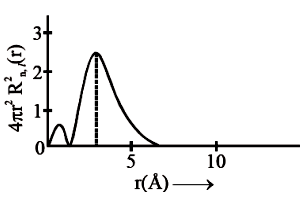A gas absorbs a photon of 355 nm and emits at two wavelengths. If one of the emissions is at 680 nm, the other is at:
1. 1035 nm
2. 325 nm
3. 743 nm
4. 518 nm
1. 1035 nm
The energy required to break one mole of CI–Cl bonds in Cl2 is 242 kJmol−1. The wavelength of light capable of breaking a single Cl–Cl bond is:
1. 494 nm
2. 594 nm
3. 640 nm
4. 700 nm
Given that an electron in an atom moves at 600 m/s with an accuracy of 0.005%, what is the level of certainty in locating its position?
(h = 6.6 × 10–34 kg m2 s–1, mass of electron,
em = 9.1 ×10–31 kg) :
1. 1.52 × 10–4 m
2. 5.10 × 10–3 m
3. 1.92 × 10–3 m
4. 3.84 × 10–3 m
The wavelength (in nanometer) associated with a proton moving at 1.0 × 103 ms–1 (Mass of proton = 1.67 × 10–27 kg and h = 6.63 × 10–34 Js) is-:
1. 0.032 nm
2. 0.40 nm
3. 2.50 nm
4. 14.0 nm
The energy of an electron is given by E = – 2.178 × Wavelength of light required to excite an electron in an hydrogen atom from level n = 1 to n = 2 will be:
(h = 6.62 × 10–34 Js and c = 3.0 × 108 ms–1)
1. 6.500 × 10–7 m
2. 8.500 × 10–7 m
3. 1.214 × 10–7 m
4. 2.816 × 10–7 m
The correct set of four quantum numbers for the valence electrons of rubidium atom (Z = 37) is -
1. 5, 1, 0 +
2. 5, 1, 1 +
3. 5, 0, 1 +
4. 5, 0, 0 +
The electrons identified by quantum numbers n and l can be placed in order of increasing energy as:
a. n = 4, = 1
b. n = 4, = 0
c. n = 3, = 2
d. n = 3, = 1
| 1. | (d) < (b) < (c) < (a) | 2. | (b) < (d) < (a) < (c) |
| 3. | (a) < (c) < (b) < (d) | 4. | (c) < (d) < (b) < (a) |
The radius of the second Bohr orbit for hydrogen atom is:
(Planck's Const. h = 6.6262 × 10–34 Js; mass of electron = 9.1091 × 10–31 kg; charge of electron e = 1.60210 ×10–19 C; permittivity of vaccum ∈0 = 8.854185 ×10–12 kg–1m–3A2)
1. 0.529 Å
2. 2.12 Å
3. 1.65 Å
4. 7.76 Å
The plots of radial distribution functions for various orbitals of hydrogen atom against 'r' are given below:
a.
b.
c.
d.
The correct plot for 3s orbital is:
1. (B)
2. (A)
3. (D)
4. (C)
According to Bohr's atomic theory:
| (A) | Kinetic energy of the electron is \(\mathrm{\propto {Z^2\over n^2}}\) |
| (B) | The product of velocity (v) of electron and principal quantum number \(\mathrm{(n), 'vn'\propto Z^2}.\) |
| (C) | Frequency of revolution of the electron in an orbit is \(\mathrm{\propto {Z^3\over n^3}}.\) |
| (D) |
Coulombic force of attraction on the electron is \(\propto \dfrac{\mathrm{z}^3}{\mathrm{n}^4}.\) |
Choose the most appropriate answer from the options given below :
1. (C) Only
2. (A) Only
3. (A), (C) and (D) only
4. (A) and (D) only










